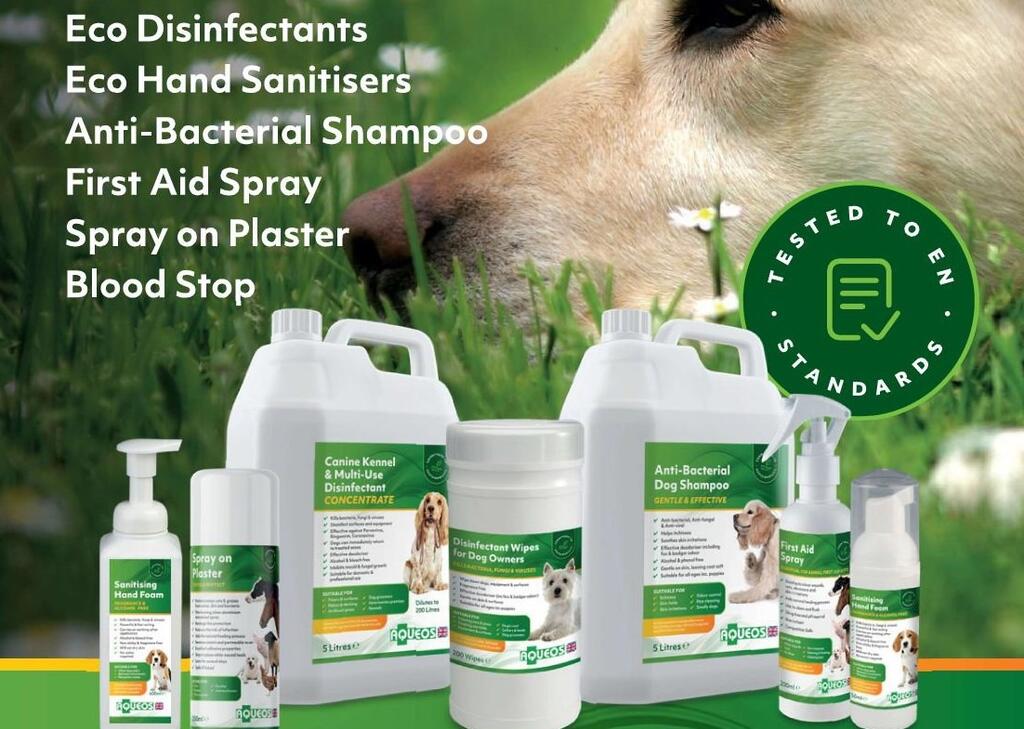AQUEOS DISINFECTANTS – WHY YOU SHOULD CHECK FOR STANDARDS

DISINFECTANTS – WHY YOU SHOULD CHECK FOR STANDARDS AND WHAT ARE EN1276, EN1650 AND EN14476
Good, effective cleaning and disinfecting protocols are essential in all animal care settings. While it may not be the most exciting subject, it’s a crucial one for all dog groomers!
Effective cleaning and disinfecting is important for the health of the pets you care for, as well as for your own safety. With such a huge selection of products on the market, the choice can feel overwhelming. So, let’s take a look at the importance of selecting the correct disinfectant, and how to choose between them.
WHAT’S THE DIFFERENCE BETWEEN CLEANING AND DISINFECTING?
Cleaning and disinfecting are both important steps in your protocol. They have very different, but equally important jobs.
CLEANING:
The first step should always be to wipe away any material such as hair, urine (wee) or faeces (poo). Next, clean and dry the surfaces. This can be done with a damp cloth, or a mild pet-safe detergent solution.
The aim of cleaning is to remove any physical matter from the surface you are cleaning. This step is crucial because dirt, hair and other matter will reduce the effectiveness of disinfectants.
DISINFECTING:
The process of disinfecting reduces the number of microorganisms (such as bacteria, viruses and fungi) to a safe level. Disinfectants work by killing or inactivating these microorganisms.
Disinfectants can’t work through grease and dirt. Cleaning the area before disinfecting allows direct contact between the disinfectant and the microorganisms.
Some disinfectants are able to clean and disinfect at the same time, as long as the instructions are closely followed.
While good cleaning just requires attention to detail and some elbow grease, effective disinfecting requires the right products. How do we know which products to use? This is where testing and standards come in.
REGULATION AND TESTING OF DISINFECTANTS
Testing disinfectant products in Europe involves testing to the European Norms (EN), also known as European Standards. The EN specifies test methods which assess how effective disinfectant products are. In other words, EN-certified products have been tested, shown to be effective and meet the EN standards. The EN testing uses test methods based on everyday use, so provides a useful tool for comparing disinfectants.
European Standards are given a reference code containing the letters ‘EN’. Let’s take a look at what they mean.
WHAT DOES EN1276 MEAN?
EN1276 is a test that determines the bactericidal activity of chemical disinfectants, meaning their ability to kill bacteria. This test is used for hand and surface disinfectants for domestic, food and industrial use.
EN1276 certified products are effective against bacteria such as E.coli, Staphylococcus aureus and Pseudomonas aeruginosa.
WHAT DOES EN1650 MEAN?
EN1650 assesses the fungicidal activity of chemical disinfectants, meaning their ability to kill fungi, including yeasts. This test is used for hand and surface disinfectants for domestic, food and industrial use.
EN1650 products are effective against yeast, such as candida albicans and other fungi, such as Aspergillus.
WHAT DOES EN14476 MEAN?
EN14476 assesses the viricidal activity of chemical disinfectants, meaning their ability to kill viruses. This test is used for disinfectants intended for domestic, industrial and medical markets.
EN14476 certified products are effective against viruses such as norovirus and adenovirus. They are often also tested for effectiveness against influenza and coronavirus (check the label).
HOW TO CHOOSE A DISINFECTANT
The main purpose of a disinfectant is to kill or inactivate microorganisms (so bacteria, viruses and fungi). So, when choosing a disinfectant, it’s important to consider:
its ability to kill or inactivate any microorganisms of concern in your grooming parlour or animal care setting, and
whether the correct application of the disinfectant suits your protocols.
For example, some disinfectants will have a required ‘contact time’ to be effective, meaning you have to leave them for a set time before rinsing or wiping them away.
With so many options on the market, the choice can seem overwhelming! Here’s where regulation and testing come in, so you can relax in the knowledge that you are using effective products. Standards for disinfectants are there to stop manufacturers from falsely claiming that a product is a disinfectant, or from claiming false activity or abilities of a product. In other words, they are there to protect you and your clients!
SUMMARY
Whether you’re a dog groomer or you’re working in an animal care setting, selecting appropriate disinfectants is an essential part of your biosecurity and hygiene protocol. It’s important to choose a disinfectant that is proven to be effective against a wide range of microorganisms. It should also be safe for staff, animals and the environment. Proper storage and use are also essential for both effectiveness and safety. In other words, be sure to read all the instructions, and follow them closely!
This article was written by Dr Sarah-Jane Molier BVM&S BSc MRCVS

